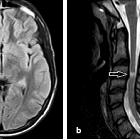schilder type multiple sclerosis
Schilder disease, also known as diffuse myelinoclastic sclerosis or diffuse cerebral sclerosis, is considered a variant of multiple sclerosis, and represents an extremely rare progressive demyelinating process that begins in childhood.
Epidemiology
The disease is extremely rare with less than 10 cases reported in the literature that fulfill the original Poser diagnostic criteria.
Clinical presentation
Symptoms include aphasia, balance instability, dementia, headache, incontinence, personality changes, seizures, tremors, visual disturbances and weakness.
Diagnostic criteria
Proposed by Poser in 1985, all six criteria must be met :
- 1-2 large plaques: should be in each brain hemisphere predominantly in centrum semiovale, lesions are greater than 2 cm in 2/3 dimensions
- no additional lesions identified
- no peripheral nervous system abnormality
- normal adrenal function
- normal serum long chain fatty acids
- pathological/histological changes consistent with subacute/chronic myelinoclastic diffuse sclerosis
Radiographic features
MRI
Schilder type multiple sclerosis is characterized by 1-2 large demyelinating plaques, which are hyperintense on T2-weighted images, in each cerebral hemisphere, predominantly in the centrum semiovale. Lesions typically are greater than 2 cm in diameter .
Typically, the cerebral cortex, cerebellum, brainstem, and spinal cord are relatively spared .
Treatment and prognosis
Patients have a poor prognosis. Current recommendations are high dose corticosteroids and supportive care .
History and etymology
Shilder disease is named after Paul Ferdinand Schilder (1886-1940), the Austrian psychiatrist and researcher who first described the disease in 1912.
Differential diagnosis
Appearances, clinical presentation and histological findings are similar to tumefactive demyelinating lesions, and it has been proposed that Schilder type multiple sclerosis may actually merely represent the pediatric version of tumefactive demyelinating lesions .
Appearances are also similar to Marburg variant of multiple sclerosis, although the brainstem is usually spared, and response to steroids is more common .
Siehe auch:

 Assoziationen und Differentialdiagnosen zu diffuse myelinoclastic sclerosis:
Assoziationen und Differentialdiagnosen zu diffuse myelinoclastic sclerosis:
